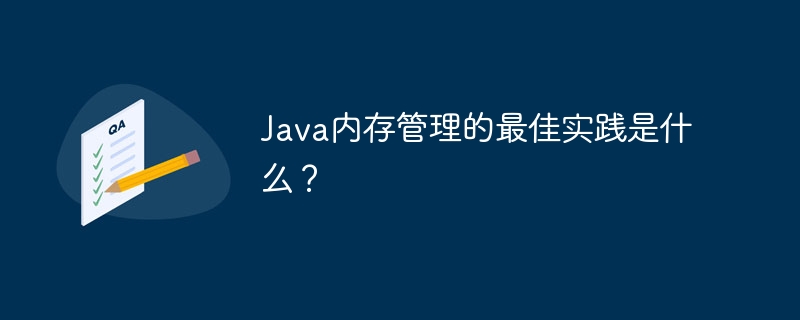What are the best practices for Java memory management?
Best practices for Java memory management include: Understanding the object life cycle. Use weak and soft references. Optimization algorithms and data structures. Reuse objects. Use boxing and unboxing.

Java memory management best practices
Introduction
Java is a garbage collection ( GC) language, which means it automatically releases objects that are no longer used. While the GC does simplify memory management, it's still critical to design code that helps improve its performance and efficiency.
Best Practices
1. Understand the life cycle of objects
Understanding the life cycle of objects is critical to effective memory management. Objects allocate memory when they are created and are reclaimed by the GC when they are no longer available. Avoid creating unnecessary objects and promptly release objects you no longer need to reference.
2. Use weak references and soft references
Weak references and soft references can help you control memory recycling behavior. Weak references do not prevent the GC from reclaiming the object, while soft references are only reclaimed when the system runs out of memory. This is useful for managing large objects that are accessed infrequently.
3. Optimize algorithms and data structures
Choosing appropriate algorithms and data structures can significantly affect memory consumption. For example, using a hash table may be more efficient than using a linked list, depending on the application.
4. Reuse objects
You can save memory by reusing objects instead of creating new objects. This can be used for threads, connection pools, and other shared resources.
5. Use boxing and unboxing
Boxing and unboxing create additional objects and increase memory consumption. Use primitive types whenever possible.
Practical Case
Consider the following example:
public class Example {
private List<String> data;
public List<String> getData() {
if (data == null) {
data = new ArrayList<>();
}
return data;
}
}This code is created every time the getData() method is called New data list. This causes a memory leak because new lists are constantly being created regardless of whether data is empty or not.
A better approach is to create the list only when data is empty:
public class Example {
private List<String> data;
public List<String> getData() {
if (data == null) {
data = new ArrayList<>();
}
return data;
}
}By following these best practices, you can optimize your Java application's memory management, Improve performance and prevent memory leaks.
The above is the detailed content of What are the best practices for Java memory management?. For more information, please follow other related articles on the PHP Chinese website!

Hot AI Tools

Undresser.AI Undress
AI-powered app for creating realistic nude photos

AI Clothes Remover
Online AI tool for removing clothes from photos.

Undress AI Tool
Undress images for free

Clothoff.io
AI clothes remover

AI Hentai Generator
Generate AI Hentai for free.

Hot Article

Hot Tools

Notepad++7.3.1
Easy-to-use and free code editor

SublimeText3 Chinese version
Chinese version, very easy to use

Zend Studio 13.0.1
Powerful PHP integrated development environment

Dreamweaver CS6
Visual web development tools

SublimeText3 Mac version
God-level code editing software (SublimeText3)

Hot Topics
 Square Root in Java
Aug 30, 2024 pm 04:26 PM
Square Root in Java
Aug 30, 2024 pm 04:26 PM
Guide to Square Root in Java. Here we discuss how Square Root works in Java with example and its code implementation respectively.
 Perfect Number in Java
Aug 30, 2024 pm 04:28 PM
Perfect Number in Java
Aug 30, 2024 pm 04:28 PM
Guide to Perfect Number in Java. Here we discuss the Definition, How to check Perfect number in Java?, examples with code implementation.
 Random Number Generator in Java
Aug 30, 2024 pm 04:27 PM
Random Number Generator in Java
Aug 30, 2024 pm 04:27 PM
Guide to Random Number Generator in Java. Here we discuss Functions in Java with examples and two different Generators with ther examples.
 Weka in Java
Aug 30, 2024 pm 04:28 PM
Weka in Java
Aug 30, 2024 pm 04:28 PM
Guide to Weka in Java. Here we discuss the Introduction, how to use weka java, the type of platform, and advantages with examples.
 Armstrong Number in Java
Aug 30, 2024 pm 04:26 PM
Armstrong Number in Java
Aug 30, 2024 pm 04:26 PM
Guide to the Armstrong Number in Java. Here we discuss an introduction to Armstrong's number in java along with some of the code.
 Smith Number in Java
Aug 30, 2024 pm 04:28 PM
Smith Number in Java
Aug 30, 2024 pm 04:28 PM
Guide to Smith Number in Java. Here we discuss the Definition, How to check smith number in Java? example with code implementation.
 Java Spring Interview Questions
Aug 30, 2024 pm 04:29 PM
Java Spring Interview Questions
Aug 30, 2024 pm 04:29 PM
In this article, we have kept the most asked Java Spring Interview Questions with their detailed answers. So that you can crack the interview.
 Break or return from Java 8 stream forEach?
Feb 07, 2025 pm 12:09 PM
Break or return from Java 8 stream forEach?
Feb 07, 2025 pm 12:09 PM
Java 8 introduces the Stream API, providing a powerful and expressive way to process data collections. However, a common question when using Stream is: How to break or return from a forEach operation? Traditional loops allow for early interruption or return, but Stream's forEach method does not directly support this method. This article will explain the reasons and explore alternative methods for implementing premature termination in Stream processing systems. Further reading: Java Stream API improvements Understand Stream forEach The forEach method is a terminal operation that performs one operation on each element in the Stream. Its design intention is






